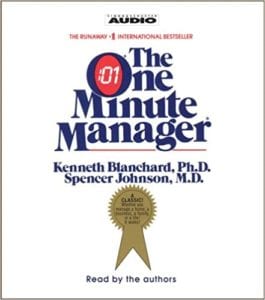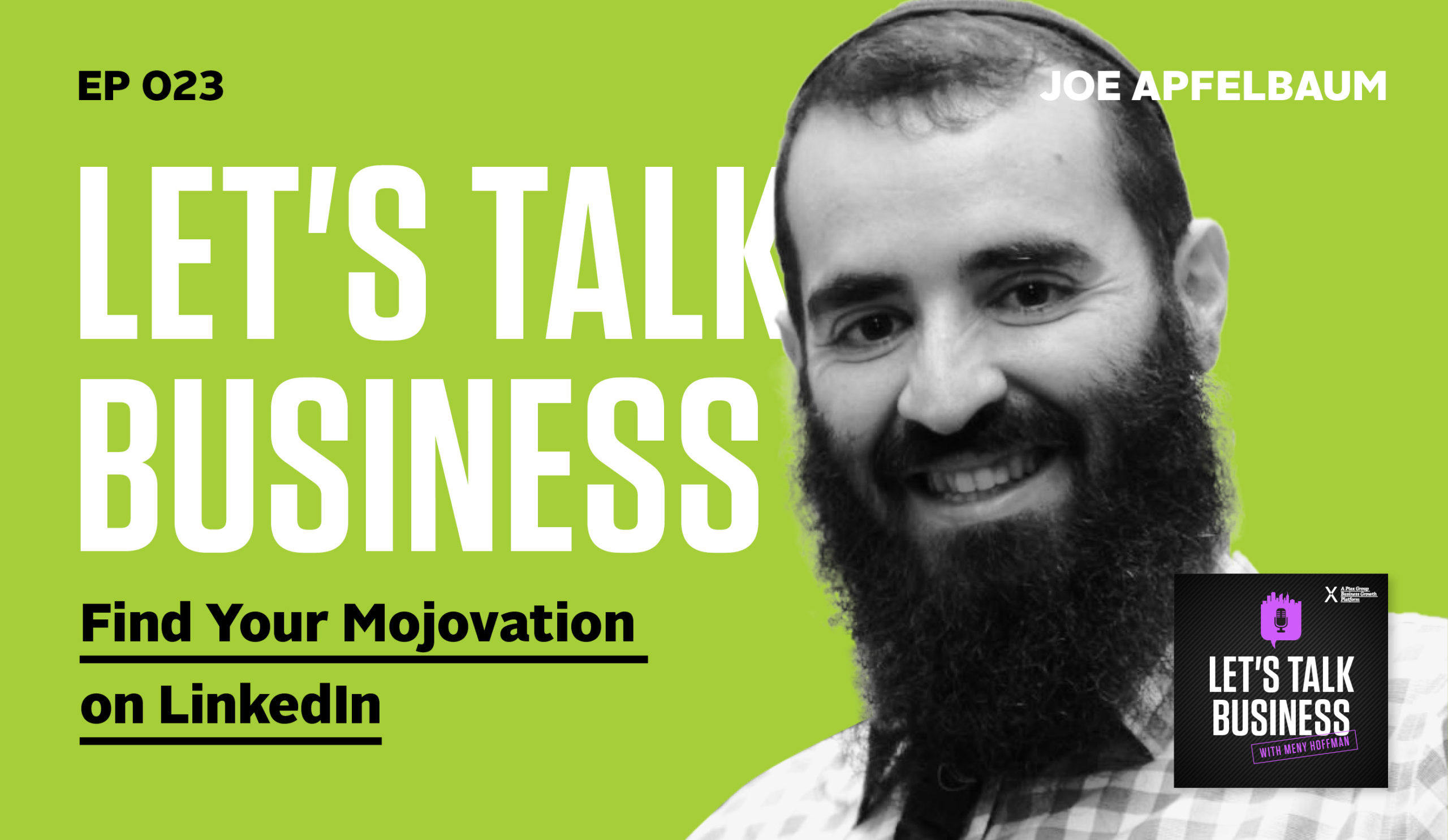In this second part of an exclusive interview, Meny Hoffman joins Chava Shapiro once more to talk about the definition and essential principles of leadership.
Coming back to the interviewee’s seat in his own show, Meny Hoffman rejoins Chava Shapiro for the second part of their exclusive interview. In this episode, they talk about all things leadership – from its broad definition to the nitty-gritty of what every contemporary leader needs to be aware of as they play their role in today’s changed and changing world. Whether you’re leading a Fortune 500 company or a small business with fewer than five employees, these leadership principles are going to resonate with you and change the way you lead. Leadership certainly isn’t easy, but it’s significantly easier if you’ve got someone by your side teaching you the ropes. Listen in and let Meny be your guide for today.
Listen to the podcast here:
Download the audio file here.
SPECIAL EPISODE: An Exclusive Interview With Our Host, Meny Hoffman—Part 2
We are back with part two of our special interview with our host, Meny Hoffman. Meny, how is it going?
Good. Thank you so much. I’m excited as I was at the first time.
This is going to be equally as valuable and interesting. We’re going to come away with lots of practical, no-nonsense advice.
You’re setting the pedestal high.
In this part of the interview, we’re going to focus on leadership, building a team, and hiring. I’m sure hiring is one of the most common questions that you get asked about.
Rightfully so because when I speak to companies that are growing, part of the growth will always be about people.

I want to start off on more of a broad note. I want to know how you define leadership.
Leadership, first of all, we’ve got to know on the standing as far as what a leader is. Once upon a time, if you looked back years ago, you will start off in a company, maybe in the stock room, maybe in the mailroom then ultimately in the assembly line. Then you move up, you get promoted until you become a manager. By definition, a manager usually means I don’t have to do the heavy lifting anymore. I’m managing other people to do the heavy lifting. This is the definition of a manager. They finally achieved this that they don’t need to do the heavy lifting. When you turn it around into becoming a leader, it changes things around and saying, “Now that I’m a leader, I have to do more. I might not do the same type of work I’ve been doing until now but now my responsibility is the way that my day-to-day activities carry is way more.” The responsibility is something that the person needs to ask themselves, “Are you ready? Are you up to the job in order to become that leader because now people are depending on you?”
That’s the first fundamental part of a person making the shift of, “Now I am the leader, my people are depending on me, I need to give them the comfort and the support. I need to lead them the way and ultimately be alongside as they do the day-to-day operation because the team has grown and there’s more than one person doing this job.” Versus back to the olden days where you are a manager and nobody likes to be around the manager because being around a manager is getting more work to do. When you’re around a good leader, you want to be as much time around the good leader because every time around my leader, I know I’m going to learn something new. That will be my intro to understanding the definition of a leader when it comes to the difference between a leader and a manager.
How would you define leadership? You only have one sentence. How do you narrow it down? I’m not going to give you a word limit but let’s say one sentence. How would you define it?
Leadership is all about the people you lead, not yourself. That’s the essence. The essence is when your manager is all about you and who works for you. When you’re a leader, it’s making it all about the people that you lead versus yourself.
What do you mean by that?
[bctt tweet=”Leadership is all about the people you lead, not yourself.” via=”no”]
When you are a leader, the thought process in your day-to-day activity is, “How could my team be better? How could I make this Josh on the team? How could I make Sally and the team be better at what they’re doing? What support could they need from me? Emotional, physical, sometimes it’s training. What type of support could I do for them?” Those people depend that the growth of the company, the growth of our division, the growth of our team will depend on the leader. We’ll be doing what we need to do best on a day-to-day activity. The leader will lead the company, lead the mission. The easiest examples will be from the military, which is all about the different titles on those different leaders. Those people that are leading teams, they’re not exempt. They’re not sitting in a mahogany desk office and leading the troops. They’re with the troops into those battlefields. However, they know, “These are my men, these are my people and I’m going to care for every single person making sure they are ready, willing and able and I’ll be there to fight with them. I’ll be there to win with them. I’ll be one of them.” That’s leadership. That’s what we expect in every leader in every company because that brings out the best of everybody.
This idea like if we fall, we’re in it together. We’re in the trenches together. It’s not about my ego and me being this big leader, I’m above everyone. It’s about me being able to lead while also connecting with the people that I’m leading and helping them become the best that they can be.
A leader must check their ego at the door. If you lead by ego, that means you’re a manager from the olden days. Leadership is all about looking at your team before yourself.
I’m wondering if we can get even a little more clarity, what does it look like to lead without ego versus what does it look to lead with your ego, front and center?
Leading with ego means it’s all about me. It’s about me winning. I don’t care who falls from my team, who was left behind on my team. Leading without ego means that I’m here, we’re here for our mission. We’re here to support the growth of the company, growth of the division. I’m bringing everybody alongside me. I’m going to be there to support them. I don’t care about who gets the credit. People sometimes confuse ego with confidence. A leader without ego is a leader that leads with humility. A leader without confidence is no leader. A leader has to show confidence because that shows for the team that we’re going to get over it when we have an issue or may have a stumbling block. I’m a leader without ego, they lead with humility, which means that I’m humble about what we do, how I speak and to be around so people are not afraid whatever I’m going to say, it’s going to be used against me or so on and so forth.
Do you think people are born leaders? Do you think it’s a teachable skill?

A teachable skill. Most people are not born leaders. As a matter of fact, people that are born as leaders usually lack the compassion and the humility that an everyday person has. Great leaders come from people being in the trenches, pushing themselves to heights, working on themselves, adding more skills, working on themselves as far as getting to achieve higher results and ultimately arriving to become a leader of a team. Some people will never be the example leader that will write in books. They might be a great leader for their small team, which is perfect for what they need and then there are leaders that could lead hundreds of people or hundreds of employees and larger companies.
There are leaders that could change the world with innovation and in different projects they are involved with. It depends on which stage your business is, on which stage you need to lead but when you have a smaller company, nobody should be able to be exempt in saying, “I cannot lead because I wasn’t born that way.” There is stuff that you could do to learn it, to dive deeper a little bit on it, which is, first of all, it’s understanding the person that you’re leading, understanding how a day in the life works, understanding people in general, understanding how to communicate and speak to a person that the person should appreciate the conversation versus feeling the tough love.
It’s also getting feedback from your own team, that’s where the humble leader comes into play is, “I’m new at this. I just became a leader. I was promoted.” Sit down with 4 or 5 people that you’re going to be leading from here on and say, “I was one of you. I worked in the same team but now the CEO hired a leader. He wanted somebody to be the go-to person and he doesn’t want to deal with everyday operations. I want to be supportive of what you do. What is a good way we could communicate? What is a good way we could share feedback? Have those conversations. It’s the best thing that could happen to build a great relationship with the people that you lead.
There are practical tips and advice that you could do as a leader. There’s a book that I’ve probably given out hundreds of times in the past for people that are starting to go from leadership, it’s called The One Minute Manager. It’s a small book and an easy read. You can read it with 1 or 2 large coffees. It gives you some practical advice on how to become a good leader as you’re starting off to become a leader. As you’re advancing your leadership, you always want to improve. That’s where leadership improvement has to be built into your daily operation and your daily activities. It could be listening to podcasts, on this show alone with many people speaking about leadership. Going back to one of the episodes, I remember it was the CEO of WD-40. They have an amazing company, a great culture and great leaders. We had the CEO of 1-800-GOT-JUNK?. A lot of episodes, only on that topic. Read good books, convince yourself and put things into action, not only read good books and then challenge yourself that, “What did I learn from this book that I could implement immediately into my daily routine with my people?”
I’m wondering what you think about this but life experience, I feel like people who perhaps were in a position where they had a leader that didn’t do a good job or that they felt was lacking in some way, they often make the best leaders. They’re learning from their own experience and they know how it felt to be on the other side of the table. At least that’s what I find. I’m wondering if you find that too.
The most important part of this equation is that any leader needs to know, regardless of where you start, where you are, is personal development, personal growth is never ending. If you speak to a leader and it says, “I know everything, I’m Mr. Know-it-all.” You know that that leader has hit a plateau and they’re not going to be able to grow or the team will not be able to outgrow. There’s a quote that I use a lot in the leader’s forum that we do. An organization will never outgrow its leader, from Dave Ramsey. It’s a great quote. The message of that is if the leader doesn’t constantly continue to grow, he or she will hold hostage either on the whole organization if they are the top or their team because the people in the team could only grow as much as their leader is growing or pushing them to the limits. It’s a never-ending game. This test, you could ask yourself, if you feel that you are Mr. Know-it-all and you don’t have a routine of learning more and pushing yourself to limits, you know that you hit the plateau and you’ve got to get started running again.
[bctt tweet=” Version one is always better than version none.” via=”no”]
We’re finding ourselves in such a unique time. The pandemic changed it. It brought to the surface a lot of issues that companies were dealing with that may have been buried. This pandemic brought a lot of that out. I know you’ve written articles and you’ve spoken about different ways that companies have dealt with this and pivoted but I’m wondering specifically, what do you think we can learn about leadership from the way that businesses have either reacted in a negative or positive way to all the changes that we’ve been experiencing?
One thing is I’ve been speaking to leaders in large companies, I’m talking about Fortune 100 companies and below that on different occasions, directly or indirectly some of those conversations. The common theme that I heard from a lot of those leaders was that they found out that things could take way quicker to implement than they used to think of in the past. Think about a larger company that wants to make a pivot, change something in their operation or introduce a new service, we got used to a certain complacency that it takes you so long in so many, “Let me make sure that we cross all the T’s and I all the dots.” Until we finally do a beta and launch it, we get some feedback and then we make changes, until it’s ready for prime time. What this showed us is that you need to have your business plan, you need to know your vision but you’ve got to be able to pivot or adapt to circumstances.
You’ve got to sometimes act fast and timing is everything. The great leaders that history will write about in the years to come based on how they dealt with 2020 hopefully at the end of it are some of those leaders that made huge changes that change their whole business. We have companies that went offering their service remote or companies that pivoted to offering their services online versus traditional in-store pickup, companies that offer technology. Companies have pivoted offering different services that could potentially be in the next several years their most successful launch of a product or service in their entire life span of the brand. That’s something that we should learn for. Let’s hope it will never be again in times like this, but we should learn. The word that’s been used for years already, agility. The company that will be growing rapidly in the next several years will be companies that are adopting and operating under agility, which means they have an agile approach towards everything they do because like this, you’re getting stuff faster out and it’s not compromising quality. It’s trying to peel the onion and give them a juice and get to the bottom of stuff way quicker than you used to do stuff.
It almost reminds me of that Silicon Valley model of idea, create it, iterate, put it out, get the feedback, iterate again. It’s almost like be okay with somethings imperfect but we’re going to do our best, put it out there and then we’re going to grow incrementally instead of sitting on something and waiting. It’s like a technology model that more businesses are implementing.
I know some of the readers are almost freaking out and saying, “What happened to first impression is everything? How could you put out something that’s not perfect?” I get that. I want to clarify. Agility is something that needs to be adapted in every business differently. We’re not speaking about getting a wrong first impression. Let’s give you a simple example. Let’s say you and I want to meet about a new project and maybe I will ask you after this show, we need to talk about this new project, this new guide that we’re putting out and the default most people will say, “Let’s schedule something. How about next Monday?” Most of the time it’s perfectly fine but with agility, you could ask yourself, “It’s just fifteen minutes. How about we stay a little longer on this show after and we speak about it?”
If I’m available, the second we say Monday, first of all, there are a couple of days until next Monday and then there is a calendar invite that goes out and then now my day, Monday, I have blocked out half an hour. Maybe it’s only fifteen minutes. We live in a world that we got so immune to our calendar and I invite now, there is a place for it. If people are running their schedule, they should work out and run their schedule accordingly. I live by my calendar because that’s how I make sure that everything important gets the right time for it. Agility, it’s how we do stuff. It’s not just what we’ve put out there as a first draft, the second draft, the third draft. It’s how we could approach things, how we could arrive at the destination easier, quicker, without complacency, and without compromising the quality.
Do you think there’s also a certain element of not needing things to be 1,000% perfect? It doesn’t have to be a product. It could just be even an initiative in the company itself.

There are two sayings that I say I have said thousands of times. In almost every talk that I give publicly somewhat, it’s going to come in. Either don’t let perfection get in the way of progress or version one is always better than version none. Any of the two work, which means is yes, you have people that are sitting on their ideas, sitting on their business plan, sitting on their marketing strategy again and again without putting it out there. Finally, they’ve spent so much effort and they’re not seeing as much results that they expect, they get frustrated, and it almost shuts them down versus give it a thought, plan it out, put it out there, get some feedback and then constantly improve.
We need to put a disclaimer depending on what it is. People always ask me about brands. Let’s say one of the niches that we work on is a lot of the eCommerce brands and the product branding that we do and we have this question all the time, “I’m going to be selling on Amazon. I’m building a brand. Should I do it the right way from the get-go or should I put it up and do it with whatever I have and then eventually come back?” If you want to give it all you’ve got and you want to launch it the proper way, you want to have people getting connected to your brand, seeing the messaging of the brand, the brand story, their narrative and everything else and you want to be at a certain price point. There is something about doing it right from the get-go. That’s exactly agility. Agility is not a blanket word. It’s, when applicable, use agility to get quicker to your destination. Agility is more of a mindset than, “How do I do it?” There is no guide of, “How do I do it? How do I work? How do I operate with agility?” There’s a mindset on how you operate with agility. Have that mindset and always question yourself. The way that you’re doing it, should the length of the project take this long? Have you done certain steps that are making it take longer or dragging it out and ultimately not arriving to the destination quickly enough?
Can you give an example of how you’ve implemented this mindset either at Ptex or how you’ve seen it being implemented in other businesses?
First of all, the example I mentioned before is companies that potentially, in the past, to roll out a program, it’s a minimum nine-month project to roll out a new project. The different people involved with different opinions you need to get versus prototyping and getting it out. Even in Ptex, when the pandemic hit and especially in the eCommerce space I mentioned, people were pushing out quicker stuff, nursing homes, the healthcare, we have a lot of customers in that space. People were needing stuff quicker for their teams, for families, for different communication. Before agility, the mindset would be, “Let’s figure out how long it’s going to take. Let’s give you a timeline. Let’s put it into the queue and a workflow.” Now we say, “This shouldn’t take more than 3, 4 hours. I know that this person is blocked out for the next week or two but this is an important project for the client. We’ll find those three hours and we’ll schedule a day to get right to it, deliver him a draft. If he likes it, that’s great. If he doesn’t, we’ll tweak it, fix it up and send it back to the client.” PR ties the work that you get in your agency based on the needs of the client, and understanding that this does need all hands on deck in order to deliver your draft.
I want to move on to hiring a little bit. What do you say when people ask you for your advice and they say they’re having trouble with hiring? They’re not able to find the right people for the right jobs or they’re having trouble fitting people into the organization. How do you address that? What advice do you give to business owners?
There’s a lot to speak about hiring. I will mention it for those people that attended our Leaders Forum or planning to attend the Leaders Forum. We have a Leaders Forum, which is a full day of training. A couple of hours are spent on this topic but high level. First of all, one of the biggest mistakes in hiring, depending on the size of the company, this is the 1st hire, the 10th hire, 100th hire, I see companies that don’t have a clear responsibility description of what they want the person to do. We’re not talking about you have ten customer service reps and you’re hiring eleven customer service reps because that person is coming in, they’re going to be manning the phones. They’re going to be responding to emails and they’re just another person in the team. I’m talking about if it’s a company that you’re hiring your first employee or you’re hiring a leader or a specific person to do a certain role, you want to be clear with what your expectations are. What is that responsibility that you want that person to have? A lot of people say, “What do you mean I don’t have? I want this to do a little bit of everything.” That’s the fundamental. Something that I teach a lot and I speak a lot on the topic, every function of a business needs to be in a box. We discussed it a lot.
[bctt tweet=”Leadership is about looking out for every individual in your team. A happy team makes happy customers. Happy customers make a happy bank.” via=”no”]
There’s a concept of organizational charts. If you google organizational charts, you’re going to get these large boxes and they’ll say this person works for this person and this person direct reports to this person. It’s more or less that we have 100 employees, we want to know where everybody is in the equation and the organization is going to show you who is leading who. I feel that anytime somebody opens a business and then this is homework for the readers, if you’ve never done it regardless of where you are with your business, do it. You’re going to see how this exercise will enlighten you, the way you look at your people and the way you look at your business growth and hiring in the future, which is take every function of your business and put a box. It could be across each other. It could be up and down. At this point, it’s a box on a sheet of paper and you could do it electronically or pen and paper, whatever works for you.
Let’s say it would be sales, marketing, bookkeeping, operations, purchasing, whatever your business needs. In bookkeeping, it might be accounts payable, accounts receivable. You could divide it as many boxes as you want that fits your business model. Once you have all those boxes, you are going to assign a name that goes alongside that box, chances are, if you are starting your business, your name will be on every single box. If you are starting a business with a partner, chances are that between you and your partner will be on every single box. If you have already five employees, it could be that you start finding out that some of the boxes have more than one name. That’s the first red flag. When a box has more than one name, you’re going to ask yourself, “Who is responsible for that? Who is helping you out with that?” You cannot have two people responsible because at that point, you cannot hold people responsible and accountable. That’s going to be the first step for this exercise is figuring out, do you have 1 and 2 each box?
Going back to your question about the hiring, when you are looking to hire and you want to build a responsibility to the description, you’re going to ask which box is that person filling out? Chances are, maybe that person will fill up more than one box. That’s fine but you need to know that the day they start or two months into the job, they’re going to be taking those responsibilities. They might be training at one point. They’re going to lead those two boxes. That’s how you hold people accountable. You work with them ongoing for training but when there’s vagueness and no clarity then that becomes a huge mess because that confuses busyness with effectiveness. The person feels like, “I’m so busy, I’m probably valuable for the company.” You as a business owner could think, “They’re busy but they’re not making money for the company. They’re not moving. They’re not valuable for the company.” Why? You and they, the two sides are looking at different things versus there was clarity from the get-go what their responsibility will be. You’re looking at that clarity on that document to see how they are progressing, how they’re doing with that job.
Once you find the right people, how do you make sure that they are bought in to the mission? They’re as excited about the company and its success as the business owner?
When you’re interviewing candidates, you’re not interviewing only on skills, you’re interviewing culture fit, buying into the mission and vision of the company and you’re hiring on skills. There’s an old saying that hire on attitude and train on skills. We’re not talking about an engineer that needs to man a machine that only a couple of people know how to fix or we’re looking at a special Java programmer that the skill is important. You can’t bring in somebody that has zero clue on Java development and saying that they’re a great culture fit and then they’re going to learn everything on the job.
Depending on what the job description is, skills they could constantly learn if they’re humble, smart, hungry and personality-wise, they want to accelerate, learn the job, and be here for a long time. You’ve got to feel them out to make sure that when they’re coming into your company, are they going to be a great asset to the environment or be toxic? Unfortunately, I can’t stress this enough. Many people are held hostage by people in their own company that they’re contaminating the environment. I have a story. Somebody had his lead salesperson who was so toxic that the owner of the company decided to work most of the days remotely because he couldn’t comment on his own company. How sad is that? They should never be held hostage by a person in their company because they are not a culture fit.

Culture fit is important. Buying into the mission? Of course. Why? If they buy into the mission of the company, when you have this urge to improve, urge to move quicker, urge to customer satisfaction, those things make a huge difference because every person in the team is putting it in perspective. What will this do for our bigger mission? What will this do for our bigger vision? Core values in a culture of a company is important. There’s so much more to talk about culture but to answer the question on hiring, you equally need to interview for that versus just for the skill.
I’m curious why you think people will keep toxic people in their company. Why not just let them go?
Sometimes it comes because a person is feeling unsecure. Let’s say the story on the salesperson. This person said, “This is my top sales guy. If I let him go, who knows what will happen with sales?” At one point, I asked him the following question and this was after a couple of conversations we had about this person, I said, “Do you want to stay? This should be your company. You’re going to make a lot of money but you won’t be able to make clear judgment calls and grow your company because this is the people that you’re working with.” At one point, I said, “You’ve got to make a decision, what you want for yourself.”
He came back to me a couple of weeks later, he says, “I’m making a decision. I’m going to let this person go.” I said, “The day after you do this, call all your people and tell them what this decision meant for you and for the business.” I coached him on how he should speak to his people. I told him to say, “This was hard for me to do. I know that this person was toxic. I know all of you felt that not only myself but ultimately, about 50% of the sales came in from this one individual. I was afraid what this will do for the company.” He said this almost the same exact words that I mentioned to you. Do you know what the reaction was? Most people stood up and said, “Thank you for this. We almost couldn’t bear coming into work. We promise you, we as a team, we’ll make out the 50% you lost.”
The moral of the story is these are not just stories that you read in books. These are stories you hear every single day. These are stories that the readers probably are saying. This is exactly how I feel on the different sides of the equation. There is something that you can do about it because if you stand up as a leader, we’re going to finish the way that we started off about leadership. Leadership is about looking out for every individual in your team. When there’s somebody that’s toxic on your team, everybody else is feeling it. If the rest of the people are feeling it, they’re not living up to their full potential. When you’re looking out for your team as a leader, you’ve got to know what is best for the team as a whole and not for what is best for one individual and your team. When you do that, you build that atmosphere and environment. You’re able to make a difference on those people that you lead. When you make a difference on those people that you lead, ultimately, they make a difference in your bottom line. They are the people that are growing. It’s the saying that I always say, a happy team makes happy customers, happy customers make a happy bank, which ultimately you see in the profits at the end of the year or gross sales in your company.
That’s a great way to end off. Thank you so much.
I’m looking forward to part three. For the readers because we’re doing something different, I’m not the interviewer, I’m being interviewed, if you appreciate your feel that the information that we’re sharing is valuable, drop me an email. Send an email to Podcast@PtexGroup.com or find me on LinkedIn at Meny Hoffman. Let me know if you liked this episode, we should do more of those episodes or if there are topics that you feel that we should discuss and also suggestions on other guests. We are interviewing other guests as well. We’re not going to change the whole concept of the show. We want to bring you content from all over but if there’s content that we could share internally, we’re here to share. If you’ve not joined our mailing list to get all about our events and about stuff that we do or guides, the best way to get on our mailing list outside of the show, it’s PtexGroup.com/join. Make it a great day.
Thanks, Meny. Take care.
Links Mentioned:
- The One Minute Manager
- WD-40 – past episode
- 1-800-GOT-JUNK? – past episode
- Podcast@PtexGroup.com
- PtexGroup.com/join
- www.MenyHoffman.com
- https://www.LinkedIn.com/in/menyhoffman/








